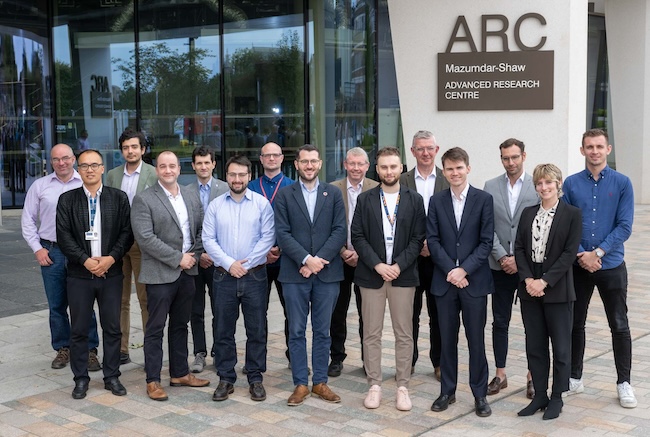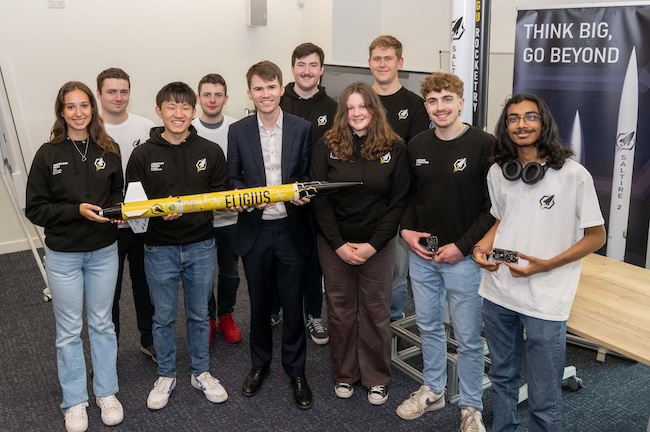Stellar reception for University of Glasgow space research as MP and MSP visit
Published: 2 September 2024
Researchers from the University of Glasgow have showcased their development of cutting-edge space technology for visitors from the UK and Scottish Parliaments.
Researchers from the University of Glasgow have showcased their development of cutting-edge space technology for visitors from the UK and Scottish Parliaments.
Gordon McKee, MP for Glasgow South, and Paul Sweeney, MSP for the Glasgow region, visited the Mazumdar-Shaw Advanced Research Centre (ARC) on Friday 30 August to learn more about the University’s diverse range of space-related research.
The main focus of the event was a presentation of the University’s student-led OirthirSAT nanosatellite project, which won £600,000 in funding from the LaunchUK Nanosatellite Design Competition in 2021.
The competition, supported by UK Space Agency, Department for Transport and the Civil Aviation Authority, challenged students across the country to design a satellite capable of monitoring climate change from space.
Joe Gibbs, a postgraduate researcher in the James Watt School of Engineering, is Programme Engineering Manager for the project. He arranged the event to showcase the positive impact of government investment in student education in the space sector, with OirthirSAT and University of Glasgow graduates regularly progressing into space-related careers across the UK and Europe.
OirthirSAT aims to demonstrate the in-orbit processing of multispectral satellite imagery, culminating in the extracting of shoreline position information which will be used by researchers to develop models of coastal erosion. OirthirSAT team member Freya Muir, of the School of Geographical & Earth Sciences, recently won an award from the British Federation of Women Graduates for her related research on coastal geomorphology.
The team’s mission design could be easily adapted to produce datasets on other coastal change processes or applied to environmental challenges including tracking vegetation boundaries and forest or farm borders.
The research project is currently in the procurement phase and the student team will begin assembling and testing the nanosatellite later this year, before presenting a flight model for qualification review in April 2025.
Labour MP Gordon McKee said: “I am delighted to have been able to visit the University of Glasgow to witness first-hand the incredible work that students and staff have been undertaking.
“The OirthirSAT project shows that investment in satellite technology can deliver benefits across society.
“Identifying coastal erosion from space will help policymakers face up to the climate emergency and protect our natural environment.
“The new UK Government is determined to ensure that Scotland and Britain continues to lead the world in technological development as part of the mission to secure the highest economic growth in the G7.”
Paul Sweeney MSP said: “I enjoyed visiting the Mazumdar-Shaw Advanced Research Centre to learn more about the University’s research in the space sector.
“From listening to the students and researchers working on the OirthirSAT nanosatellite project, as well as members of the GU Rocketry and GU Orbit student societies, it was apparent to me that the University of Glasgow is at the forefront of innovation in satellite technology and has an exciting future in space-related research.
“The unprecedented growth in the Space sector is a significant economic opportunity for Glasgow, which has already established itself as an international leader in the design, manufacture and management of small satellites.
“With this concentration of innovation and expertise at the University of Glasgow, and with Scotland on the cusp of having an orbital launch capability, the city is well placed to lead the development of space industries.”
After hearing about the current and future projects from leaders in the Space Glasgow research group, Mr McKee and Mr Sweeney met student societies, researchers and academic staff for an informal poster session. The visitors had the opportunity to learn about ongoing research projects including the modelling of coastlines using satellite imaging, mission design for responsive space debris removal and attitude control of large space structures.
Members of the GU Rocketry and GU Orbit student societies showcased the Saltire-01, Saltire-02 and Regulus launch vehicles which are developing to demonstrate novel technologies.
Dr Kevin Worrall, of the University of Glasgow’s James Watt School of Engineering, is the academic supervisor and principal investigator for the OirthirSAT project. He said: “We were delighted to welcome Mr McKee and Mr Sweeney to the ARC to learn more about the varied and multidisciplinary space research underway across the University, from space law and business to low TRL space missions and satellite subsystem design.
“It is great to see this level of support and interest from our local parliamentary representatives. It’s a credit to the amount of work the OirthirSAT team has put into the project, along with the LaunchUK Team.
“The hands-on experience and learning opportunities OirthirSAT supports helps to support the development of talent who can find space-related jobs both locally and across the UK’s growing space sector."
Professor David Flynn is head of the James Watt School of Engineering’s Research Division for Autonomous Systems and Connectivity. He said: "Aerospace research and teaching in the University of Glasgow is built on a 74-year legacy of pioneering research leadership. Today, we are celebrating the hard work, talent and success of our colleagues and future research leaders, as well as the supportive and creative research environment Glasgow offers as an integral contributor to the UKs space sector.
“Glasgow’s expertise is internationally recognised in all areas of aeronautics and aerospace, communication, sensing and imaging systems. Today’s event was a fantastic showcase for how we are continuing our pioneering research, establishing emergent fields and supporting the UKs talent pipeline in of space technologies."
First published: 2 September 2024




